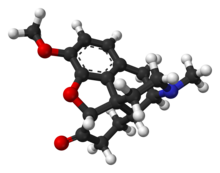1H-NMR & 13C-NMR of hydrocodone (1)
hydrocodone as a pale-yellow solid.
1H NMR (300 MHz, CDCl3) δ 6.72 (d, J = 8.2 Hz, 1H), 6.65 (d, J = 8.2 Hz, 1H), 4.68 (s, 1H), 3.92 (s, 3H), 3.20 (m, 1H), 3.04 (d, J = 18.5 Hz, 1H), 2.59 (m, 2H), 2.49–2.27 (m, 6H), 2.21 (td, J = 11.9, 3.3 Hz, 1H), 2.08 (td, J = 12.0, 4.5 Hz, 1H), 1.86–1.79 (m, 2H), 1.35–1.19 (m, 1H).
13C NMR (75 MHz, CDCl3) δ 207.89, 145.39, 142.82, 127.24, 126.28, 119.76, 114.47, 91.39, 59.19, 56.75, 56.71, 46.89, 46.83, 42.88, 42.70, 40.23, 35.52, 25.57, 19.95.
 HYDROCODONE
HYDROCODONE
hydrocodone as a pale-yellow solid.
1H NMR (300 MHz, CDCl3) δ 6.72 (d, J = 8.2 Hz, 1H), 6.65 (d, J = 8.2 Hz, 1H), 4.68 (s, 1H), 3.92 (s, 3H), 3.20 (m, 1H), 3.04 (d, J = 18.5 Hz, 1H), 2.59 (m, 2H), 2.49–2.27 (m, 6H), 2.21 (td, J = 11.9, 3.3 Hz, 1H), 2.08 (td, J = 12.0, 4.5 Hz, 1H), 1.86–1.79 (m, 2H), 1.35–1.19 (m, 1H).
13C NMR (75 MHz, CDCl3) δ 207.89, 145.39, 142.82, 127.24, 126.28, 119.76, 114.47, 91.39, 59.19, 56.75, 56.71, 46.89, 46.83, 42.88, 42.70, 40.23, 35.52, 25.57, 19.95.
 HYDROCODONE
HYDROCODONE
Hydrocodone, a high value active pharmaceutical ingredient (API), is usually produced in a semisynthetic pathway from morphine, codeine or thebaine. The latter alkaloid is an attractive precursor as it is not used as a remedy itself. The key step in this production route is a selective olefin reduction forming 8,14-dihydrothebaine which can be subsequently hydrolyzed to yield hydrocodone. Unfortunately, standard hydrogenation procedures cannot be applied due to severe selectivity problems. A transfer hydrogenation using in situ generated diimide is the only known alternative to achieve a selective transformation. The most (atom) economic generation of this highly unstable reducing agent is by oxidizing hydrazine hydrate (N2H4·H2O) with O2. In the past, this route was “forbidden” on an industrial scale due to its enormous explosion potential in batch. A continuous high-temperature/high-pressure methodology allows an efficient, safe, and scalable processing of the hazardous reaction mixture. The industrially relevant reduction was achieved by using four consecutive liquid feeds (of N2H4·H2O) and residence time units, resulting in a highly selective reduction within less than 1 h.
Selective Olefin Reduction in Thebaine Using Hydrazine Hydrate and O2under Intensified Continuous Flow Conditions
† Institute of Chemistry, University of Graz, Heinrichstrasse 28, A-8010 Graz, Austria
‡ Noramco, Inc., 503 Carr Road, Suite 200, Wilmington, Delaware 19809, United States
Org. Process Res. Dev., Article ASAP
DOI: 10.1021/acs.oprd.5b00370
Publication Date (Web): December 15, 2015
Copyright © 2015 American Chemical Society
*E-mail: oliver.kappe@uni-graz.at.
 | |
 | |
| Systematic (IUPAC) name | |
|---|---|
4,5α-epoxy-3-methoxy-17-methylmorphinan-6-one
| |
| Clinical data | |
| Trade names | Zohydro ER |
| AHFS/Drugs.com | Micromedex Detailed Consumer Information |
| MedlinePlus | a601006 |
| Pregnancy category |
|
| Legal status |
|
| Dependence liability | severe / high |
| Routes of administration | oral, intranasal, rectal |
| Pharmacokinetic data | |
| Bioavailability | High |
| Metabolism | Hepatic: CYP2D6 (minor; converts tohydromorphone), CYP3A4(major; converts tonorhydrocodone) |
| Biological half-life | 3.8–6 hours |
| Excretion | Renal |
| Identifiers | |
| CAS Number | 125-29-1 |
| ATC code | R05DA03 |
| PubChem | CID: 5284569 |
| IUPHAR/BPS | 7081 |
| DrugBank | DB00956 |
| ChemSpider | 4447623 |
| UNII | 6YKS4Y3WQ7 |
| KEGG | D08045 |
| ChEBI | CHEBI:5779 |
| ChEMBL | CHEMBL1457 |
| Synonyms | dihydrocodeinone |
| Chemical data | |
| Formula | C18H21NO3 |
| Molecular mass | 299.368 g/mol |






